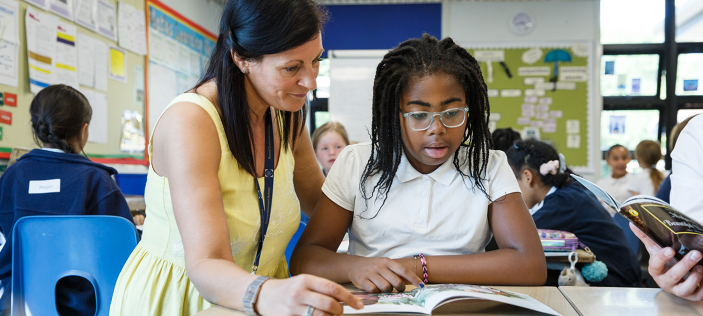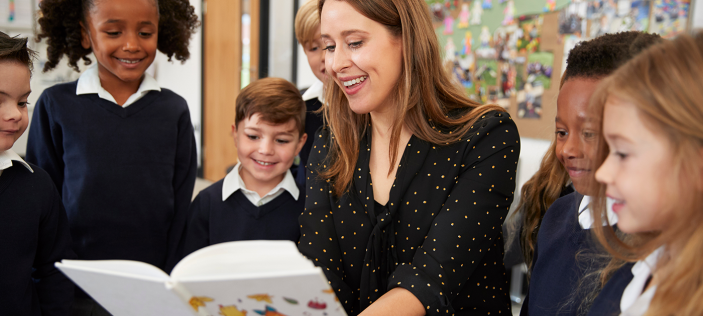With 150 pupils across Hertfordshire now involved in HFL’s KS2 Reading Fluency Project, Penny Slater reflects on what has been learned from the project so far.
Last week, HFL officially launched the first round of the KS2 Reading Fluency Project, involving 20 Herts schools. Based on our work carried out in a number of schools throughout 2016/17, we have good reason to believe that this project will go a long way towards supporting many of their year 6 pupils, who are currently at risk of falling behind, to reach the Expected Standard in the 2018 reading test.
Armed now with a great amount of qualitative data, and a growing database of quantitative data, we are in a position to share some of our early findings from this work.
The project began on a very small scale, in one school, where the SL was keen to ensure that those pupils who entered KS2 at a 2b/2c reached the EXS by the end of year 6. At the time when I was working with the school, they were concerned that many of these pupils, who were then in year 5 and year 6, would not do so. Observations of a sample of these pupils reading a well-pitched ARE text, indicated that they were far from fluent: their reading sounded choppy; robotic and monotonous. In addition, they had a disregard for punctuation, and they lacked the ability to monitor comprehension as they read (indicated by the fact that they often mis-read words, or at times completely missed out words – or whole lines of text – without realising and self-correcting). Their reading comprehension was poor (as judged by their inability to attempt many of the oral comprehension questions asked after reading the text). The school sought a swift and effective teaching strategy that would – as the lowest indicator of success – support these children to quickly gain ground in advance of the impending test, but would – at best – turn these switched-off readers onto the joys of this particular pastime.
We decided upon a strategy that we initially named ‘modelled fluent reading’ sessions, but now, as the project launches into full swing, this has evolved into a more sophisticated model. The current project supports teachers to embed the following strategies into regular reading sessions of engaging, well-pitched ARE texts: modelled fluent reading; text marking; echo reading; opportunities for repeated re-readings and performance. The schools are asked to work with six children over an 8-week period, offering a double-dose of guided reading: session 1 to focus on modelled fluent reading practice and echo reading, and session 2 to focus on comprehension development. Following trials over the summer term in a number of different schools, led by HfL advisors Sabrina Wright and Kathy Roe, we can now present our early findings:
It works (for most children):
Of the 29 children who took part in the summer trials, 23 children made gains in comprehension of between 4 months and 5 years. Out of the number of pupils who made 4 months-plus progress in reading comprehension over the 8-week period, 16 children made over one year’s progress (10 pupils in that group made over 2 years’ progress!).
Data was gained using the YARC reading comprehension test.
It did not work for a small number of children:
Our trials helped us to refine our understanding of whom this project really helped. Six children did not make more than 8 weeks progress in their comprehension following the project. Much of our discussion following these trials have focused on what it was about these particular children that meant that they did not benefit from the project. As is often the case, each child prompted a different theory, but factors we have considered are as follows:
- Dislike of the project method – one child was particularly shy and disliked the reading aloud element of the project
- Pupil selection – in some cases, pupils’ fluency didn’t seem to be the barrier to learning and those pupils therefore didn’t make as much progress with their comprehension. We refined pupil selection criteria as a result
All of these considerations have enabled us to better support schools in selecting pupils who are most likely to make gains as a result of the methods used in the project.
More than simply reading aloud:
Repeatedly, we discovered that simply reading aloud to the children (despite doing so in a perfectly fluent and engaging fashion) did not support their comprehension development as much as we had anticipated. Because we found this aspect of our study so interesting, we explored it repeatedly during our trials. Through doing so, we reaffirmed our observation that echo reading (where a child has the opportunity to hear the words on the page spoken by their own voice following modelling by an ‘expert’ reader) allowed for better comprehension, compared to when the text was simply read aloud to the children. We have not yet gained quantitative data to support this finding (partly because the YARC test does not allow for this analysis) but we witnessed it time and time again during our observations and trial sessions.
Watch your speed:
Most teachers lament the fact that many of their children simply do not read quickly enough to get through the reading paper in time to have a hope of reaching the expected standard. I have long wondered whether this is the case, or whether the problem is that they read it too quickly, and too passively, merely hoping that by passing their eyes over the words, the meaning hidden within them will leap into their panicked brains. If they do this, then they will probably end up having to read the text over and over again during the test simply because it did not go in the first time. It might be more time-efficient, to read it a bit slower, but better.
Our small-scale studies showed that out of the 23 children who made gains in comprehension, seven children actually reduced their reading rate – their reading got slower! Eight of the pupils increased their reading rate (although all marginally) and the remaining eight recorded the same reading rate as their pre-intervention score.
Our study also revealed that prior to the project, the selected pupils rarely self-corrected as they read, demonstrating a lack of understanding. One child replaced the word monk with monkey and continued on, unaware. The same child read again from a ‘cold’ piece at the end of the 8 week project and re-read sentences and words for sense as she went along, demonstrating that she was ‘taking in’ the text. This may have slowed her pace, but aided her comprehension and retrieval.
It is important to get the simple things right:
When summing up our work to teachers and other colleagues, we have been struck by how the techniques we propose could be neatly summed up in a few minutes – or a few sentences, as above. However, as we state on our whole day project launch, it takes time, effort and skill to get the simple things right. In order to effectively model fluent reading, teachers have to be acutely aware of what fluency is, and what it sounds like when reading an age-related text. Prosody being perhaps the most challenging aspect of fluency, we support teachers to apply their own prosodic knowledge to the analysis of a challenging text that would test even an expert reader’s prowess. This proves to be a real eye-opener for many teachers and helps them realise what a door-opener prosodic knowledge is to reading comprehension. Teachers also need to gain confidence in knowing what a good text choice looks like if it is both going to inspire a reluctant reader to read, and prepare them for success in the KS2 test. Finally, teachers need the time and space to reflect on their current practice and consider how this is contributing – or not – to the development of prosodic understanding. All of these things take time, practice and most importantly, headspace: something that we try to offer on our launch day.
Children enjoy it!
We knew from our early work – which relied predominantly on watching the transformation in children’s reading following a well-planned modelled fluency session – that children got so much more out of the sessions than simply better comprehension skills. When we observed children complete a cold read of an unknown text after 20 minutes or so of intensive reading work, the children had changed. Not only did they read better and certainly they understood a lot more, but there was more to be observed: they sat up a little straighter; they turned the pages with a little more gusto; they inhaled breath a little less dramatically between each sentence (in the baseline observation, one child gulped air between each sentence as if he were preparing for the next bout of a wrestling match). Most notably, fatigue did not hit quite so hard and so fast. The children kept going, or ‘performed’ (to mimic the language we use on the project), for longer, and appeared to enjoy doing so. The results of the pupil voice surveys from our summer trials confirmed that the techniques used in the project go further than simply preparing children for a reading test. Below are some of the quotes from children and teachers who took part in the summer trials.
Has it made you feel differently about reading?
– I didn’t think I noticed it helped, but I’m reading a lot more.
– I used to read David Walliams, but now I’m reading Alex Ryder because I liked the suspense stories we read.
– I’m reading more mysteries and suspense now.
– It’s made me step up the hours. I’m reading more now.
– I’m reading with more expression. It made me enjoy reading more and choose a different variety of books.
Teacher Comments:
-The children have really enjoyed the sessions and having a challenging text.
– The children seem a lot more confident.
– The children in this group seemed more resilient during an end of year assessment. They are the children that may have previously given up.
– This project enabled me to know the Y6 text pitch really well.
– It meant they had exposure to texts like the end of year assessments.
– I have struggled to get ‘X’ to pick up a single narrative this year, and now he is reading Roald Dahl.
– The children have been taking the skills they’ve been learning and applying these outside of the sessions.
We acknowledge that we are in the early stages of our work, but with 20 schools (and 150+ pupils) launching whole-heartedly into the project last week, we look forward to developing our knowledge of how these techniques can help to raise reading standards, and to sharing these findings in the near future.
Read more about the HFL Reading Fluency Project or contact reading.fluency@hfleducation.org
With thanks to the following schools for their participation in the summer trials:
Beechfield Primary School, Watford
Woodhall Primary School, Watford
Summerswood Primary School, Borehamwood
De Havilland Primary School, Hatfield
With special thanks to Reedings Junior School, Sawbridgeworth for their early involvement in the project.
Reading that informed the project:
- Dowhower (1994) Repeated Reading Revisited: Research Into Practice, Reading and Writing Quarterly, 10
- EEF (2017) Improving Literacy in Key Stage Two, Guidance Report
- Heitin (2015) Literacy Expert: Weak Readers Lack Fluency, Not Critical Thinking
- Heitin (2015) Reading Fluency Viewed as Neglected Skill, Education Week, http://www.edweek.org
- Marcell Putting Fluency on a Fitness Plan, The Reading Teacher Vol 65 issue 4
- National Institute of Child Health and Human Development (2000) Report of the National Reading Panel; Teaching Children to Read: An evidence-based assessment of the scientific research literature on reading and its implications for reading instruction, US government Printing Office
- Rasinski, Yildirim, & Nageldinger (2011) Building Fluency Through the Phrased Text Lesson, The Reading Teacher Vol 65 issue 4
- Rasinski (2012) Why Reading Fluency Should be Hot!, The Reading Teacher Vol 65 Issue 8
- Rasinski (2014) Delivering Supportive Fluency Instruction, Reading Today
- Rasinski & Nageldinger (2016) The Fluency Factor: Authentic Instruction and Assessment for Reading Success in the Common Core Classroom, Teachers College Press



